Physical Address
304 North Cardinal St.
Dorchester Center, MA 02124
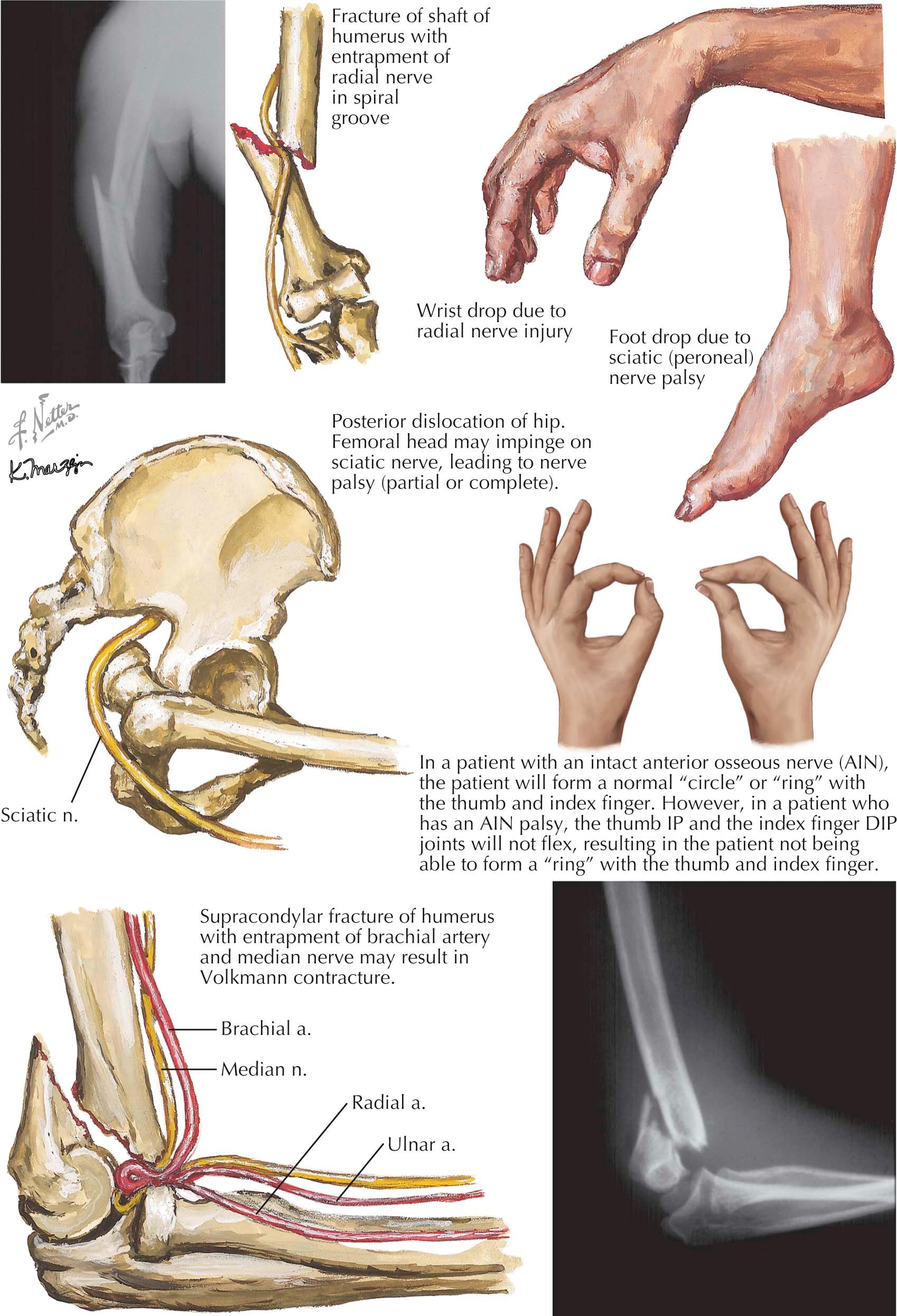
Displacement of fracture fragments or bone ends at a dislocated joint carry the risk of producing compression or laceration of adjacent vessels and nerves (see Plate 9-1 ). Critical neurovascular structures (e.g., the brachial plexus) lie deep in the limb, close to the skeleton, which protects them from injuries. A fracture or dislocation makes nerves or vessels vulnerable to injury from sharp bone fragments or from entrapment in the fracture site.
Neurovascular complications must be identified by careful examination immediately after the injury and after any manipulation of the injured limb. Some complications are not immediately evident but appear 24 to 48 hours after injury. Re-examination and monitoring are essential both during this period and while circular compression dressings and casts are in place. Prompt and sometimes aggressive treatment is required to restore function and prevent permanent loss.
Radial Nerve Palsy. The radial nerve is the most commonly damaged nerve after fractures of the distal shaft of the humerus. Normally protected in the spiral groove of the humeral shaft, the nerve is susceptible to stretch, direct injury by a fracture fragment, or entrapment in the fracture site itself. Aggressive manipulation of the fracture during closed reduction may also result in nerve entrapment. Although wrist drop is the consequence of radial nerve injury, this is most often a neurapraxia, with nearly 100% recovery in low-energy trauma patients and over 33% recovery in high-energy trauma patients despite the method of treatment. Recovery of motor strength may take multiple months to occur, but radial nerve palsy in itself is usually not an indication for surgery.
Sciatic Nerve Palsy. Nerves and vessels at or near joints are particularly vulnerable to injury. The neurovascular structures are more securely tethered to the soft tissues around joints than elsewhere and are less likely to escape injury when significant joint displacement occurs. For example, the sciatic nerve is at risk in posterior dislocation of the hip, with injury occurring at a rate of approximately 13% in simple dislocations. Generally, the nerve is simply stretched or contused by direct impingement of the femoral head. The peroneal branch is most commonly affected, the sequela of which is foot drop. Immediate reduction of the dislocation relieves pressure on the nerve, and about two thirds of patients are likely to recover partial to full motor and sensory deficits. A possible indication for surgical exploration might be a patient in whom no neurologic deficits were present until after manipulation and reduction of the joint.
Neurovascular Injury About the Elbow. A musculoskeletal injury that is frequently associated with neurovascular injury is the supracondylar fracture of the humerus. It is most common in children between 3 and 10 years of age and usually results from a fall on the outstretched hand. In the most common type of fracture, hyperextension injury, the distal fracture fragment is displaced posteriorly, which can result in the critical neurovascular structures anterior to the elbow becoming tethered on the anterior edge of the fractured humeral shaft. The median nerve and the brachial artery are both particularly susceptible to direct injury from the displaced fracture fragment and can be lacerated or entrapped in the fracture site at the time of injury or during the closed reduction. A common neurologic sequela is damage to a branch of the median nerve, the anterior interosseous nerve, which results in the inability to flex the interphalangeal joint of the thumb and the distal interphalangeal joint of the index finger. The anterior interosseous nerve is readily assessed by asking the patient to make an “OK sign” with the thumb and index finger. Distal neurovascular function must be assessed critically both before and after any treatment, and manipulative reduction must be careful and gentle.
Compartment Syndrome. Direct damage to an artery or severe swelling in a muscle compartment can lead to development of compartment syndrome. This serious outcome is common after any fracture in which bleeding and swelling are extreme. Compartment syndromes can occur with open as well as with closed fractures and may also be caused by a circular cast. Failure to identify compartment syndrome early may lead to permanent loss of limb function.
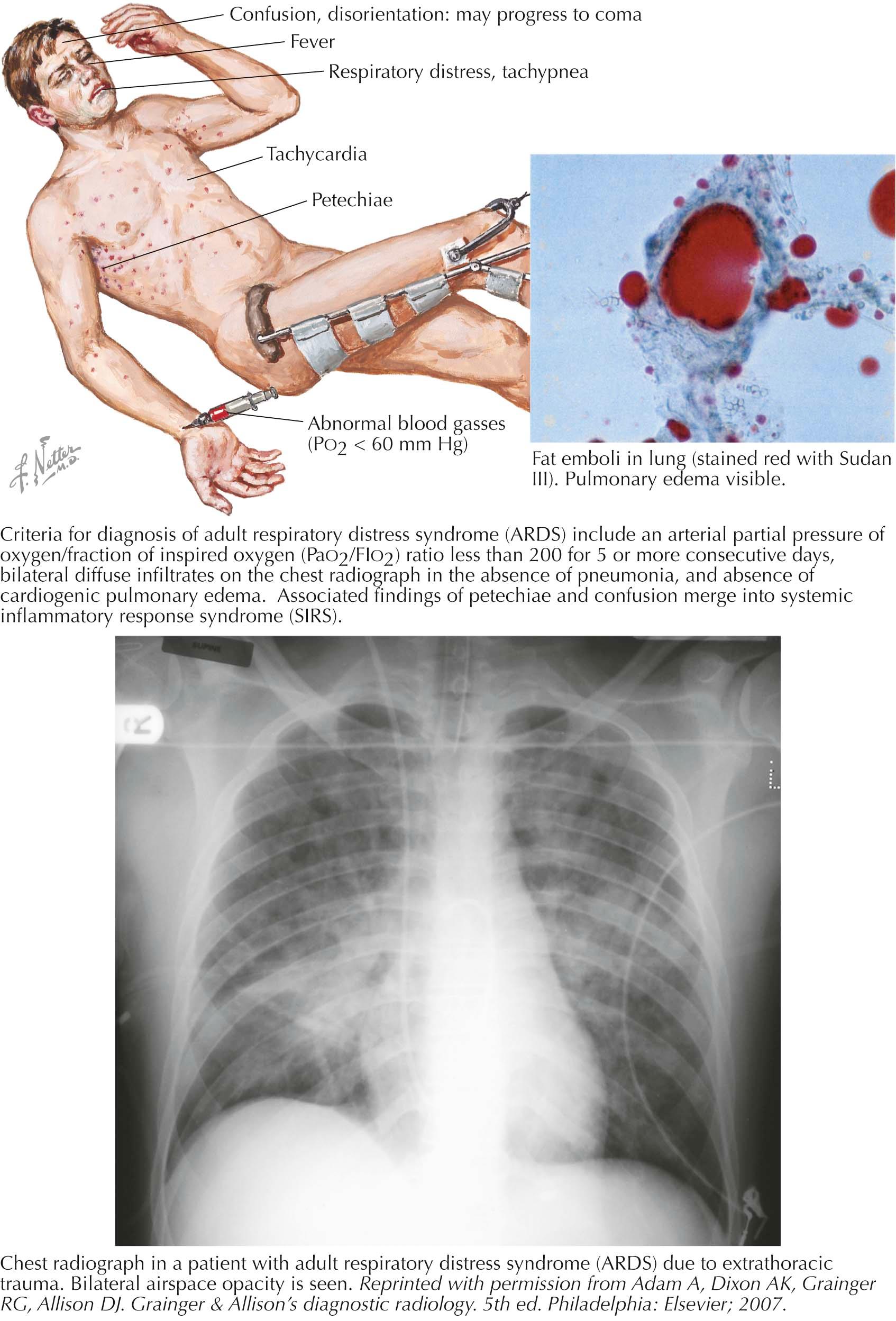
Respiratory failure often develops 24 to 72 hours after severe musculoskeletal injury. The precise pathogenesis of the syndrome is not fully understood, and many etiologic factors play a role in its development, including pulmonary embolism, aspiration of gastric contents, pulmonary edema due to fluid overload or heart failure, atelectasis, and pneumonia. Although all these conditions may occur after trauma, a specific pattern of pulmonary deficit called adult respiratory distress syndrome (ARDS) results secondary to pulmonary edema. One possible trigger of ARDS is “fat embolism syndrome,” which has been linked to fractures of long bones (see Plate 9-2 ). However, although fat embolism syndrome is more common after fractures of long bones, it has been reported after fracture in nearly every bone.
ARDS is characterized by the sudden onset of respiratory insufficiency and extreme arterial hypoxia in the immediate postinjury period. Clinical manifestations include fever, tachycardia, tachypnea, and mental confusion. Airway resistance increases, lung compliance progressively decreases, and pulmonary arteriovenous shunting becomes evident. If fat embolism syndrome is the cause of ARDS, petechiae often also develop, especially in the axillae, and arterial oxygen tension falls below 60 mm Hg.
Marrow emboli have been identified in the lungs of patients, leading to the term fat embolism syndrome, but ARDS may also develop in the absence of fracture marrow emboli. Studies have demonstrated the release of free fatty acids, cytokines, and other inflammatory cascade molecules into the blood stream, which produces characteristic pulmonary changes: congestion, atelectasis, venous and capillary engorgement, and interstitial edema. These pulmonary changes prevent the exchange of oxygen across the alveolocapillary membrane, resulting in profound systemic hypoxia. As a consequence, the patient becomes progressively more hypoxic and may die if the disorder is not treated aggressively. When ARDS is suggested, arterial oxygen tension should be determined. The severity of hypoxemia necessary to make the diagnosis of ARDS is defined by the ratio of the partial pressure of oxygen in the patient's arterial blood (Pa o 2 ) to the fraction of oxygen in the inspired air (F io 2 ). In ARDS, the Pa o 2 /F io 2 ratio is less than 200.
Great debate exists among the trauma community regarding the best methods of reducing the incidence of ARDS that follows multiple-injury trauma. This has led to the term damage control orthopaedics, which refers to the theory that surgical management of patients should be staged to minimize the systemic effects of the patient sustaining subsequent iatrogenic trauma (i.e., surgery). Because patients with multiple injuries are already “primed” for systemic inflammation due to their injuries, clinicians must be mindful to not perform nonemergent procedures before medical optimization of the patient. Clinical evidence demonstrates that ARDS can be prevented, or at least minimized, by mobilizing the patient early and avoiding prolonged bed rest and traction. These precautions require immobilization of fractures as soon as possible after the injury. Intramedullary nailing of all long bone (especially femur) fractures should be performed in less than 24 hours from injury if possible. This reduces the risk of fat embolism syndrome, ARDS, and other medical complications such as large amounts of blood loss from unreduced fractures. This is particularly important in patients with multiple injuries. Intramedullary long bone fixation allows the patient to be mobilized immediately after fracture fixation, minimizing bed rest and eliminating the need for skeletal traction.
If promptly recognized and treated vigorously, the pulmonary changes of ARDS are possibly reversible. Failure to treat the patient aggressively may be fatal. Treatment focuses on correcting the hypoxemia and maintaining arterial oxygen tension greater than 70 mm Hg until the pulmonary lesions resolve. This essentially consists of improving oxygenation by way of utilizing positive end-expiratory pressure (PEEP) to drive sufficient oxygen across the alveolocapillary membrane for adequate arterial oxygenation. Treatment may be required for 2 days to multiple weeks, depending on the severity of the pulmonary lesions. If oxygen delivered with a facemask does not restore the arterial oxygen tension to the desired level, mechanical ventilation with a closed system should be instituted. Even at this stage, fracture fixation to allow mobilization of the patient combined with vigorous respiratory therapy may help reverse the pulmonary insufficiency.
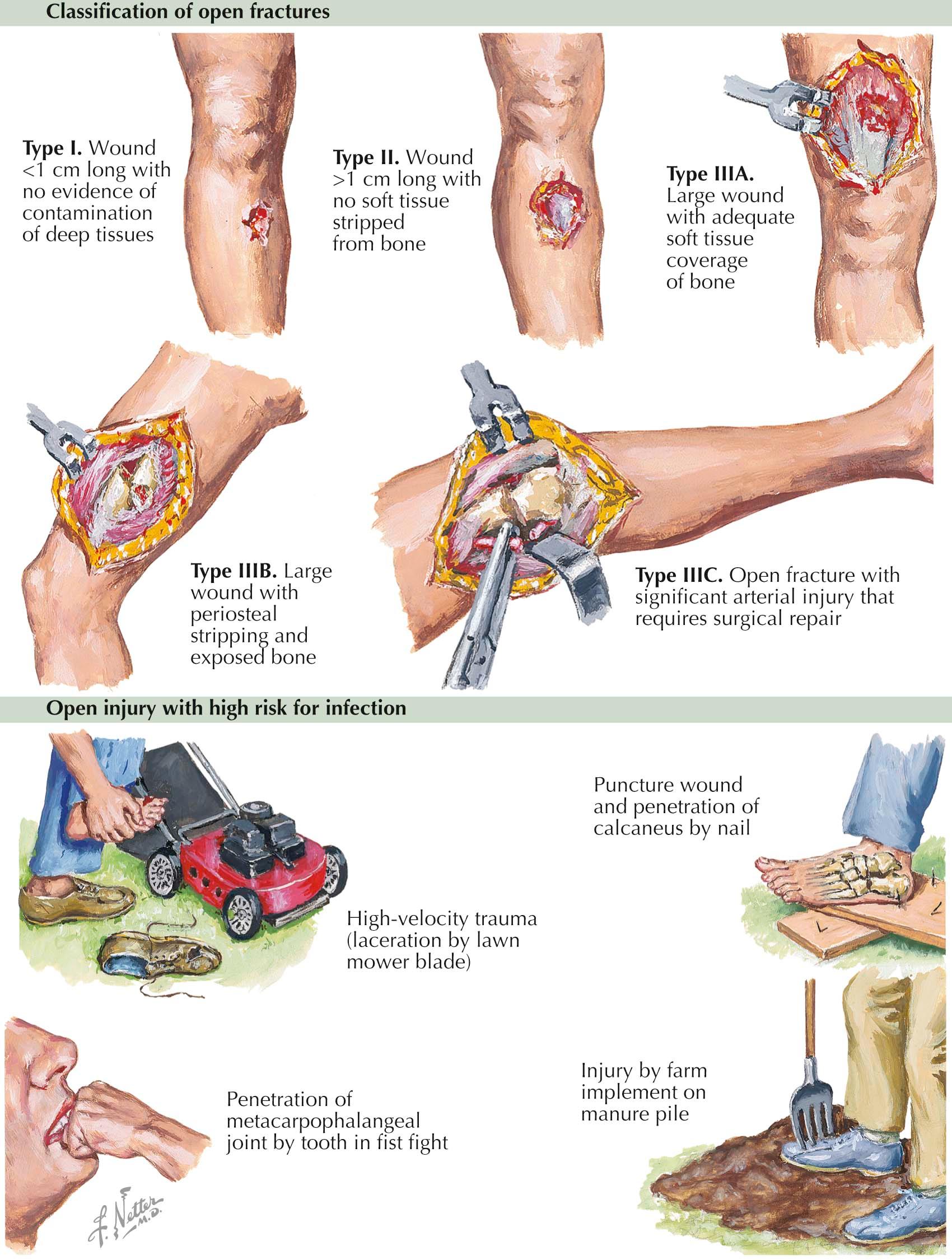
A fracture or dislocation becomes contaminated, and thus potentially infected, any time the protective layers of soft tissue enclosing the injury hematoma are violated. The hematoma is an excellent medium for the growth of bacteria, resulting in acute cellulitis or abscess or leading to a chronic deep infection of the bone (osteomyelitis). All skeletal injuries should be classified as open or closed immediately after injury. In an open fracture, the overlying skin and soft tissue have been penetrated; therefore, the fracture hematoma may be contaminated.
Classification of Open Fracture. Open fractures are graded by the severity of soft tissue damage, fracture pattern, and degree of contamination, as defined by Gustilo and Anderson (see Plate 9-3 ). In type I open fractures, the wound is less than 1 cm in length and is free of contamination. Type II fractures have a wound greater than 1 cm, but less than 10 cm, in length, and the soft tissues are not extensively stripped from the bone. In type IIIA fractures, the wound is larger than 10 cm but soft tissue coverage remains adequate. In type IIIB fractures, the wound is larger than 10 cm, the periosteum is stripped from the bone, and the bone is exposed. Type IIIC fractures have a large wound greater than 10 cm in length and have significant arterial injury that requires surgical repair. All type III injuries are generally considered contaminated and many times are the result of a high-energy gunshot, farm injury, or blast. Gustilo and colleagues noted that the incidence of infection was 1% for type I fractures, 1.8% for type II fractures, and 20.8% for type III fractures.
Contamination of Open Injury . The most important factors contributing to wound infection of an open fracture are the degree of contamination and the severity of the injury. However, even a type I wound may become infected if not adequately cleaned and treated. The potential for infection due to various strains of Clostridium (e.g., tetanus and gas gangrene, see Plate 9-5 ) always exists, because clostridia are ubiquitous and every contaminated wound may contain them.
Injuries at high risk for infection include wounds contaminated by manure or standing water (which often contains clostridia) and wounds caused by a high-velocity mechanism, such as a gunshot. An open fracture of the toe caused by a lawn mower blade, for example, is a very high-risk wound. The high velocity of the blade edge imparts tremendous energy, increasing soft tissue damage and the risk of contamination. Even in some wounds that appear trivial (e.g., a puncture in the sole of the foot caused by a rusty nail), particularly virulent organisms are inoculated deep into the wound, causing a significant infection. A puncture in the heel that penetrates the calcaneus would be classified as a type I wound; however, this type of puncture wound is notorious for becoming infected, in part because the initial treatment was inadequate. In addition, these puncture wounds are often contaminated by gram-negative organisms, such as Pseudomonas, which can cause a chronic infection that is very difficult to cure.
Puncture wounds resulting from human bites are also serious and are often initially overlooked by the patient. In a fist fight, a metacarpophalangeal joint may be punctured by a tooth and contaminated by anaerobic or microaerophilic bacteria contained in the mouth. These organisms can cause especially aggressive and destructive infections in the hand (see Section 8, Soft Tissue Infections , Plate 8-2 ). Because of this risk, the gold standard of treatment for all “fight bites” is surgical washout of the involved metacarpophalangeal joints.
Failure to remove contaminating organisms from an open fracture site may result in severe complications. Acute infections with Clostridium species, as well as with streptococci and other bacteria, can lead to cellulitis, sepsis, and even death. Even if acute infections do not develop, osteomyelitis, a low-grade chronic infection of bone, may result (see Section 8, Soft Tissue Infections , Plates 8-2, Plates 8-9 ). This condition is distinguished from soft tissue infections by its persistence and severity. Once established, osteomyelitis is very difficult to eradicate. Although soft tissue infections are usually cured by incision and drainage, bacteria can become sequestered in bone, where perfusion is inadequate and bactericidal antibiotic levels cannot be achieved. Chronic osteomyelitis may not respond to surgical debridement and intravenous antibiotics, and purulent drainage often persists.
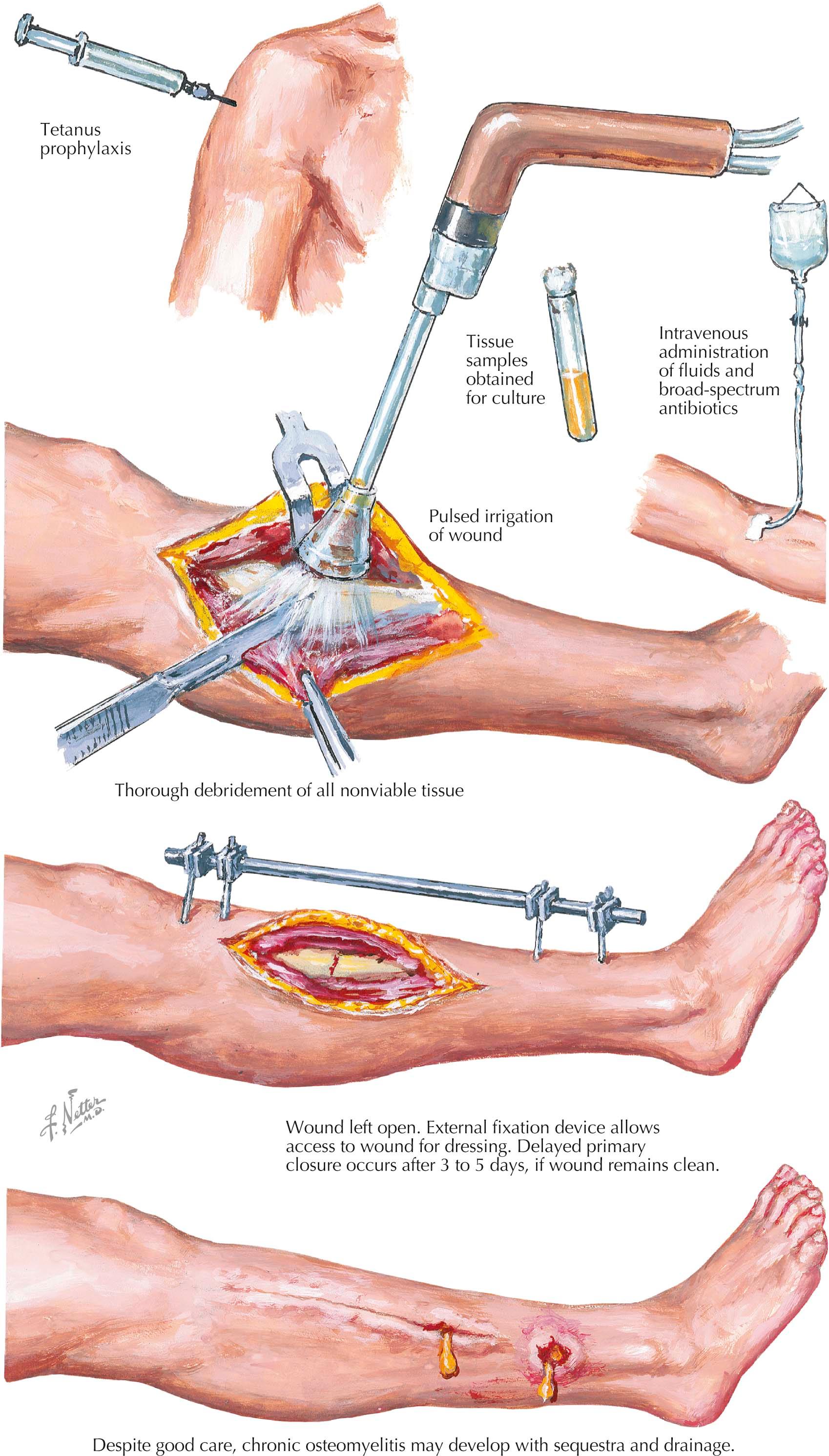
All open fractures should undergo immediate and thorough debridement to remove all contaminating material (see Plate 9-4 ). Although nearly all open fractures will require surgical debridement in the operating room, this does not negate the need for immediate debridement in the emergency department. All foreign material (e.g., dirt, grass, metal fragments) should be removed as best possible by the clinician in the emergency department, and the wound should be copiously irrigated with sterile fluid. Surgical debridement should be done as soon as possible after the injury (typically within 6 to 8 hours). Tissue samples are taken from deep in the wound, and broad-spectrum antibiotics are administered intravenously for at least 48 hours thereafter. Depending on the extent of contamination, repeat washouts in 48-hour intervals may be necessary. To avoid sealing contaminants inside the wound, many wounds are left open after debridement. Delayed primary closure of the wound can be considered 3 to 5 days after the injury if the wound remains clean; however, some studies have found decreased infection rates in patients in which a “loose” closure was performed at the time of initial debridement. For all patients with an open fracture, the immunization record is checked and adequate tetanus prophylaxis provided, if needed.
If the fracture is accompanied by severe soft tissue injury, stabilization of the fracture with an external fixation device facilitates wound care. An external fixation device will many times need to remain in place until such time that infection has been eradicated, viable soft tissues have been maintained, and swelling has decreased enough to allow conversion to an internal fracture fixation and closure of soft tissue wounds.
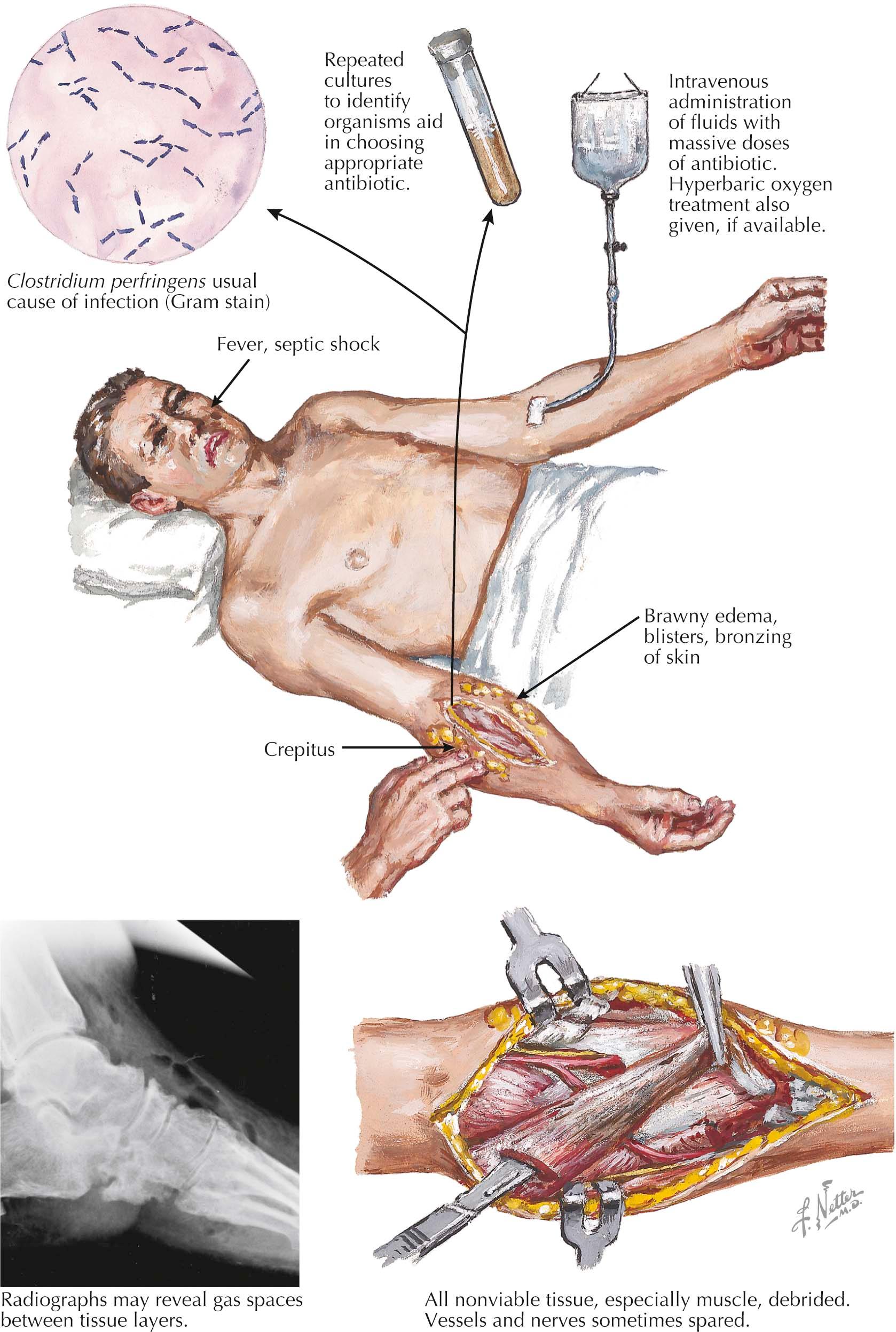
The most serious acute infection that can result from a contaminated open fracture is gas gangrene (see Plate 9-5 ), a form of myonecrotizing infection that progresses rapidly. Although the term gas gangrene is typically associated with the bacterial species Clostridium, many necrotizing soft tissue infections are caused by mixed aerobic and anaerobic gram-negative and gram-positive bacteria. Although this complication is rare, Clostridium perfringens is found virtually everywhere and should be considered a possible contaminant in every open wound. The reduced oxygen tension in the wound provides an excellent environment for the growth of clostridia.
Gas gangrene may develop when a contaminated open fracture is inadequately debrided. The infection tends to involve the subcutaneous tissue and muscles, sometimes sparing blood vessels, nerves, and bone. Once established, the infection may produce a localized cellulitis or extensive and aggressive myonecrosis. The onset of infection usually occurs within 72 hours after injury. Characteristic manifestations are localized pain, erythema, swelling, brawny edema, blister formation, and bronzing of the skin. Pockets of subcutaneous gas produce crepitus on palpation, and the wound often drains a thin, brownish, watery material. The extent of the infection will progress very quickly, with the erythematous edge of the infection spreading at a rate of up to 10 cm per hour. Severe systemic symptoms of fever, tachycardia, and lethargy may progress rapidly to septic shock and coma.
As with other wound infections, prevention is the keystone in the management of infections caused by Clostridium. The contaminated hematoma and all necrotic tissue should be debrided promptly after any open fracture. Antibiotics are administered to prevent infection, and the wound is left open. Primary closure is delayed until the wound is clean and there is no evidence of infection.
Gas gangrene is a true surgical emergency that demands immediate attention to preserve life and limb. Once gas gangrene, cellulitis, or myonecrosis develops, treatment must be swift and aggressive. The decision to proceed with operative management must in some cases be made on clinical examination findings alone, because delay for computed tomography or magnetic resonance imaging may result in the loss of an extremity or even life. Intravenous administration of fluid and blood is performed as necessary to treat the systemic complications. Large doses of broad-spectrum antibiotics should be administered intravenously the instant gas gangrene is suggested. It is essential to open the infected wound as soon as possible and perform a radical debridement of all necrotic and infected tissue. This precaution means that frequently the surgical procedures must be repeated every few hours because of the rapid and aggressive nature of the infection. Hyperbaric oxygen treatment may be considered if available; however, studies have shown mixed results with regard to benefit of this logistically difficult therapy. Intravenous antibiotics and immediate surgical debridement remain the absolute necessary treatment.
Become a Clinical Tree membership for Full access and enjoy Unlimited articles
If you are a member. Log in here